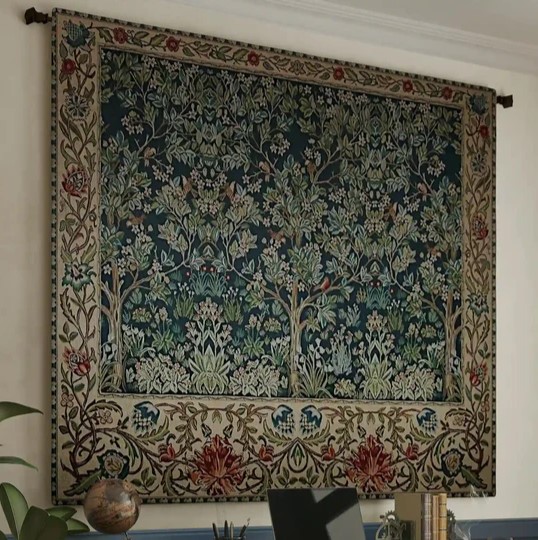Displaying antique tapestry wall hangings in your home is one of the most elegant ways to celebrate history, craftsmanship, and artistry. These intricate textiles often carry centuries of tradition, and their beauty can instantly transform a room into a sophisticated space. However, hanging them incorrectly can lead to sagging, fraying, or irreversible damage over time. Proper installation is essential to preserve the texture, color, and integrity of your tapestry while ensuring it remains a focal point of your décor.
Understand the Nature of Your Tapestry
Before deciding how to hang your tapestry, take time to assess its condition and material. Antique tapestries are typically woven from natural fibers like wool, silk, or cotton, which are sensitive to environmental conditions. Exposure to direct sunlight, high humidity, or fluctuating temperatures can cause fading or fabric deterioration.
Always choose a wall away from harsh sunlight or areas prone to moisture, such as kitchens or bathrooms. If your tapestry is particularly delicate, consider consulting a textile conservator before mounting it. This extra step ensures the preservation of historical and monetary value.
Preparing the Wall and Hanging Materials
Proper preparation is key to safely displaying your tapestry. Start by cleaning the wall to remove dust and debris, as this helps prevent stains or moisture transfer. You’ll also need to decide on the type of hanging hardware based on the weight and size of the tapestry.
For lightweight pieces, Velcro strips or a simple fabric sleeve may suffice. For heavier designs, especially those with intricate embroidery or thick weaving, a sturdy hanging rod with secure brackets provides better support. The key is to distribute the tapestry’s weight evenly across the fabric, preventing tension that can distort or tear it over time.
Using a Rod and Sleeve Method
One of the most common and safest ways to hang antique tapestries is by sewing a fabric sleeve along the top edge. This sleeve allows a rod to slide through, which can then be mounted on the wall using brackets. This method supports the entire width of the tapestry, preventing stress on any single point.
Choose a rod made of durable materials like wrought iron or hardwood. If your tapestry is large, ensure the rod extends a few inches beyond both edges to balance the weight evenly. You can also use decorative finials to add a classic finishing touch. This approach not only enhances stability but also adds a touch of elegance that complements the tapestry’s vintage charm.
Hanging with Velcro for Fragile Pieces
If your tapestry is fragile or extremely old, the Velcro method offers gentle, non-invasive support. In this setup, one side of the Velcro is sewn onto a cotton strip, which is then attached to the back of the tapestry. The corresponding side is secured to a wooden slat or mounting board on the wall.
This technique keeps the tapestry flat and prevents unnecessary handling or folding. Additionally, it allows for easy removal for cleaning or preservation. When combined with acid-free backing fabric, this method offers excellent protection against environmental damage while keeping the tapestry in pristine condition.
The Importance of Proper Support
When working with vintage tapestry wall hangings, the key is to avoid puncturing the textile with nails or hooks. Directly hanging tapestries by tacking or pinning can lead to small tears that expand over time. Instead, distribute the weight evenly using fabric sleeves, rods, or support boards.
Some collectors choose to mount their tapestries on padded boards covered with muslin or linen. This approach not only supports the entire structure but also creates a gallery-style display that looks refined and professional. If you plan to rotate your collection or frequently move your pieces, this technique is ideal for minimizing wear.
Maintenance and Long-Term Preservation
After installation, regular maintenance helps ensure the longevity of your tapestry. Dust lightly using a soft brush or a vacuum cleaner with a low-suction upholstery attachment. Avoid harsh cleaning chemicals or water, which can weaken the fibers.
Keep your tapestry away from direct sunlight and consider using UV-protective glass or window film in rooms where light exposure is unavoidable. For delicate tapestry wall hangings in antique style, a humidity-controlled environment is ideal. Excessive moisture can cause mildew, while dry air can make the fibers brittle. Maintaining stable conditions helps preserve the natural texture and vibrancy of the threads.
Display Ideas to Enhance Aesthetic Appeal
To make your antique tapestry the centerpiece of a room, consider its placement and the surrounding décor. Hanging it above a fireplace, along a hallway, or behind a sofa can create a dramatic visual effect. Pair it with warm lighting to bring out the depth and detail of the weave.
You can also mix modern and traditional elements to balance your space. For instance, pairing a historical tapestry with minimalist furniture adds contrast and sophistication. This allows your antique piece to stand out without overwhelming the room’s style.
Conclusion
Displaying and preserving your treasured tapestry requires patience, precision, and care. With the right techniques, you can protect its beauty while showcasing its rich history for generations to come. Whether it’s a small medieval textile or a large tapestry that dominates an entire wall, proper hanging ensures that it remains both a visual masterpiece and a lasting piece of art.
